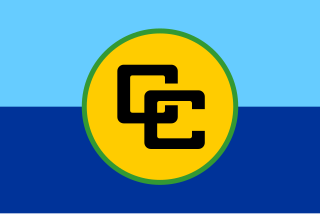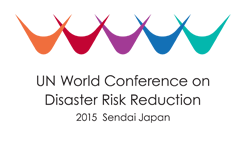
The Caribbean Disaster Emergency Management Agency (CDEMA) is an inter-regional supportive network of independent emergency units throughout the Caribbean region. Formed on September 1, 2005, as the Caribbean Disaster Emergency Response Agency (CDERA) it underwent a name change to CDEMA in September 2009.

A humanitarian crisis is defined as a singular event or a series of events that are threatening in terms of health, safety or well-being of a community or large group of people. It may be an internal or external conflict and usually occurs throughout a large land area. Local, national and international responses are necessary in such events.
The International Early Warning Program (IEWP), was first proposed at the Second International Early Warning Conference (EWCII) in 2003 in Bonn, Germany. It developed increasing importance in the wake of the 2004 Indian Ocean tsunami, which claimed over 200,000 lives and injured over half a million people.

Emergency management or disaster management is the managerial function charged with creating the framework within which communities reduce vulnerability to hazards and cope with disasters. Emergency management, despite its name, does not actually focus on the management of emergencies, which can be understood as minor events with limited impacts and are managed through the day-to-day functions of a community. Instead, emergency management focuses on the management of disasters, which are events that produce more impacts than a community can handle on its own. The management of disasters tends to require some combination of activity from individuals and households, organizations, local, and/or higher levels of government. Although many different terminologies exist globally, the activities of emergency management can be generally categorized into preparedness, response, mitigation, and recovery, although other terms such as disaster risk reduction and prevention are also common. The outcome of emergency management is to prevent disasters and where this is not possible, to reduce their harmful impacts.
The United Nations General Assembly designated the 1990s as International Decade for Natural Disaster Reduction (IDNDR).

Disaster risk reduction (DRR) sometimes called disaster risk management (DRM) is a systematic approach to identifying, assessing and reducing the risks of disaster. It aims to reduce socio-economic vulnerabilities to disaster as well as dealing with the environmental and other hazards that trigger them. The most commonly cited definition of disaster risk reduction is one used by UN agencies such as United Nations Office for Disaster Risk Reduction (UNDRR) and the United Nations Development Programme (UNDP): "DRR is aimed at preventing new and reducing existing disaster risk and managing residual risk, all of which contribute to strengthening resilience and therefore to the achievement of sustainable development".
International Day for Disaster Risk Reduction (IDDRR) is an international day that encourages every citizen and government to take part in building more disaster-resilient communities and nations. The United Nations General Assembly designated October 13 as International Day for Natural Disaster Reduction as part of its proclamation of International Decade for Natural Disaster Reduction.

The United Nations Office for Disaster Risk Reduction (UNDRR) was created in December 1999 to ensure the implementation of the International Strategy for Disaster Reduction.
The Sendai Framework for Disaster Risk Reduction (2015–2030) is an international document that was adopted by the United Nations (UN) member states between 14 and 18 March 2015 at the World Conference on Disaster Risk Reduction held in Sendai, Japan, and endorsed by the UN General Assembly in June 2015. It is the successor agreement to the Hyogo Framework for Action (2005–2015), which had been the most encompassing international accord to date on disaster risk reduction.

Robert Glasser is the former Special Representative of the Secretary-General for Disaster Risk Reduction, and head of the United Nations International Strategy for Disaster Reduction. Australian national Glasser was nominated in November 2015 by Secretary-General of the United Nations Ban Ki-moon to succeed Margareta Wahlström of Sweden, who was the first such Special Representative and had been appointed in November 2008. Glasser took up his post in January 2016. He was succeeded on 1 March 2018 by Mami Mizutori.

The All India Disaster Mitigation Institute (AIDMI) is a NGO registered in India. Located at Ahmedabad, Gujarat, India, it works on disaster risk reduction, climate change adaptation and disaster mitigation. It is a community-based ; action planning, action research and advocacy organization, working towards bridging the gap between policy, practice and research related to disaster mitigation. AIDMI have been working on six pillars: (i) Awareness generation, (ii) Capacity building, (iii) Policy advocacy, (iv) Direct implementation, (v) Research and publications, and (vi) Networking.
Asian ministerial conference for disaster risk reduction (AMCDRR) is an intergovernmental conference held to discuss disaster mitigation. Its inaugural meeting was held in Beijing, in August 2005, after the adoption of Hyogo Framework for Action (2005-2015). The conference has been held seven times in collaboration with the United Nations Office for Disaster Risk Reduction (UNISDR). The motive of such conference was to mitigate the disaster risks. After the Indian Ocean tsunami came in 2004, India was among the five countries that were very badly impacted and took prime initiative to endorse for creating new laws for disaster risk management.

Established in 1992, the Major Group for Children and Youth is the United Nations General Assembly mandated, official, formal and self-organised space for children and youth to contribute to and engage in certain intergovernmental and allied policy processes at the United Nations.
Ecosystem-based adaptation (EBA) encompasses a broad set of approaches to adapt to climate change. They all involve the management of ecosystems and their services to reduce the vulnerability of human communities to the impacts of climate change. The Convention on Biological Diversity defines EBA as "the use of biodiversity and ecosystem services as part of an overall adaptation strategy to help people to adapt to the adverse effects of climate change".
The International Recovery Platform (IRP) is a joint initiative of United Nations agencies, international financial institutions, national and local governments, and non-governmental organizations engaged in disaster recovery. IRP was founded in 2005. It came after the Second World Conference on Disaster Reduction, to support implementation of the Hyogo Framework for Action (HFA). The group works to identify and address gaps in recovery knowledge, practice and constraints. In 2015, IRP aligned its work to support implementation of the newly adopted Sendai Framework for Disaster Risk Reduction. It concentrated on Priority Four – building back better in recovery, rehabilitation and reconstruction.
Building Back Better (BBB) is a strategy aimed at reducing the risk to the people of nations and communities in the wake of future disasters and shocks. The BBB approach integrates disaster risk reduction measures into the restoration of physical infrastructure, social systems and shelter, and the revitalisation of livelihoods, economies and the environment.

Sustainable Development Goal 13 is to limit and adapt to climate change. It is one of 17 Sustainable Development Goals established by the United Nations General Assembly in 2015. The official mission statement of this goal is to "Take urgent action to combat climate change and its impacts". SDG 13 and SDG 7 on clean energy are closely related and complementary.

Sustainable Development Goal 11, titled "sustainable cities and communities", is one of 17 Sustainable Development Goals established by the United Nations General Assembly in 2015. The official mission of SDG 11 is to "Make cities inclusive, safe, resilient and sustainable". The 17 SDGs take into account that action in one area will affect outcomes in other areas as well, and that development must balance social, economic and environmental sustainability.
The Global Facility for Disaster Reduction and Recovery (GFDRR) is a global partnership program established on September 29, 2006, to support developing countries on disaster risk reduction and climate change adaptation. The facility is administered by the World Bank and governed by a Consultative Group including the World Bank Group, the United Nations Office for Disaster Risk Reduction (UNDRR) and several other international organizations and countries.

World Tsunami Awareness Day is an annual event held on 5 November to raise awareness of the dangerous effects of tsunamis and the importance of tsunami preparedness and early warning of tsunamis. It was first established in 2015 by United Nations General Assembly Resolution 70/23. On this day events are held in various countries and people are encouraged to spread awareness on social media. Tsunami awareness is very important as in the past 100 years there have been a total of 58 tsunamis with a combined death toll of over 260,000 people. Between 1998 and 2018 $200 billion was lost due to tsunamis. There is a potential for tsunami death tolls to increase in the future due to the combined effects of population increase in coastal areas and sea level rise. The official theme of World Tsunami Awareness Day 2022 is "#GetToHighGround" which encourages people to practice tsunami evacuation plans, with walks organised in Portugal and Mauritius.












